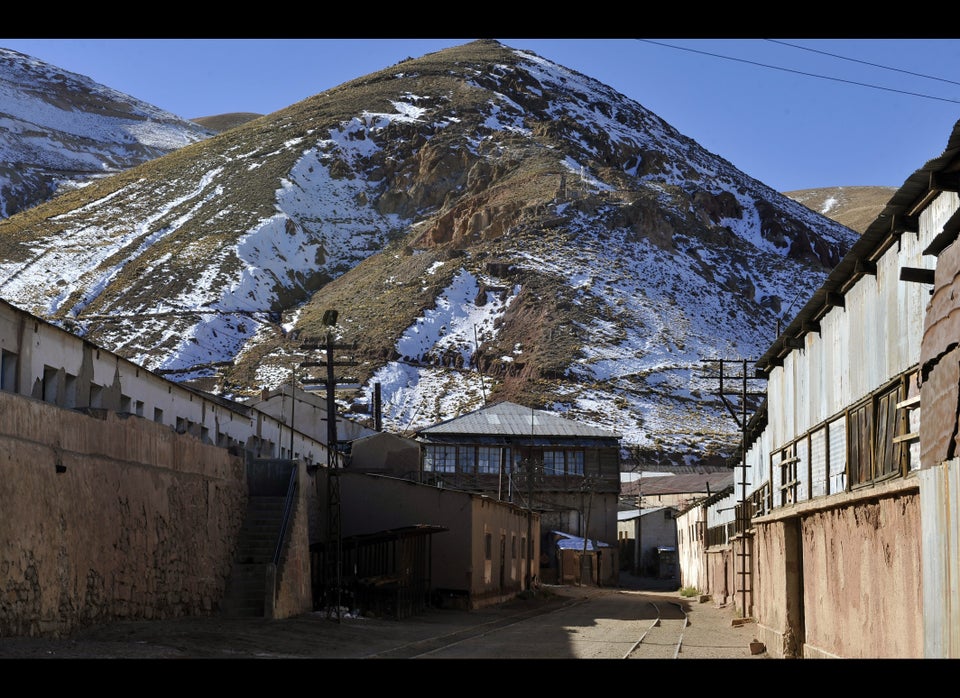It's hot and the air is thick with dust illuminated by the strong beam of your headlamp. You can't breathe, but you can't let the claustrophobia get the best of you either. You endure.
You're stumbling through still, dense tunnels studded with yellow-tinged stalactites, treading lightly on planks perched high over vertical drops, crawling through narrow shafts. You grasp at soft earth and grimy moist rock, both which stain your hands a reddish-tan and impart a mineral smell that soon seeps into your clothes and hair. It's hard to breathe, especially through the facemask you wear, the only barrier between you and silicon-saturated air.
This could be hell.
For hundreds of years, Cerro de Potosí, overlooking the town of Potosí, Bolivia, was mined for its rich silver deposits. At one point, Potosí was the richest city in South America -- and perhaps the world -- with famous silver-lined streets. While the Spanish benefited from this tremendous wealth, it came at a cost. It's estimated that 8 million slaves, many from Africa, died mining the hellish interior of this devil's mountain.
Today, Cerro de Potosí's silver deposits have been depleted, leaving behind a huge city, the highest of its size in the world, with few avenues for survival. As a result, the mountain is still being mined, but mainly for tin, lead, zinc and trace amounts of silver. When the government withdrew its support in the 1950's, no longer subsidizing the mining of the mountain, small cooperatives took over. In total, 15,000 men from Potosí work the mines. The co-ops are formed organically and their members go all in together, investing in equipment and supplies and sharing in the profits.
The expected lifespan of a Potosí miner is anywhere from 35 to 45 years old. Each man works at a manic pace, spending up to 20 hours in the mine at a time. Because of the arsenic found in the mountain, the miners do not eat inside. Instead, they chew coca leaves, which suppresses their appetites and boosts their energy levels so they can continue their desperate search for the minerals that provide for their families. The men also imbibe Bolivian "whiskey," a humble little 190-proof concoction that tastes like pure acid, sometimes drinking it straight (it can be purchased in containers the size of milk gallons), and other times mixing it with water or juice.
In order to survive, one must make certain sacrifices to appease Tío, the devil-like figure that the miners idolize. He controls the realm underneath, the realm of the miners, and exacts revenge on those who anger him. When a miner dies, it's said that Tío did not wish for him to live--so imagine the lengths that the miners will go to keep Tío happy. Stone statues, his shrine, can be found throughout the mountain and are relics of the Spaniards' attempts at terrifying the slaves into productivity. They're kept lit-up with cigarettes, quenched with alcohol, stocked with coca leaves. The saying down here: What happens in the mines stays in the mines.
Potosí was the most shocking, most haunting, and most subduing experience in all of my travels. There are no safety laws within the mines and accidents and deaths happen frequently: dynamite going off at the wrong time, falls from great heights. If silicosis doesn't strike first. In which case, the eldest son in the family takes up in the tradition of his father, because how else will his family be able to survive? While I found the conditions inhumane, unendurable, I understand that mining is one of the few opportunities that can reap tremendous rewards. If a mineral-rich vein is discovered, a miner can become extremely, extremely wealthy.
Our tour, led by a guide who actually worked in the mines, had us experiencing the life of a miner and understanding the dignity and the desperation of his livelihood. We met various members of our guide's co-op and watched them in their different roles, operating the winch, breaking apart boulders, carting away trough-fuls of rock, surveying for possible veins, drilling. We partook in drinking with our guide and a miner called Pescado (aka Fish--one of those nicknames explained with a vulgar story), making small offerings to the earth before tipping capfuls of whiskey-juice into our mouths. We met the boss of our guide's co-op, who was either out of his mind or extremely drunk. He hooted and guffawed randomly, peered brazenly at us, and made several attempts at sticking lit cigarettes into the mouth of a Tío statue until one was perched just right. Before inserting a wad of coca leaves that we'd brought him into his mouth, he urinated on his hands in order to clean off the arsenic (not crazy; a practical way to sanitize, believe it or not).
When the tour was finally over, I stumbled towards the opening, savoring the sweet fresh air which rushed dizzily into my lungs. In gratitude, I whispered a quick word of thanks to Tío for letting me live another day.
